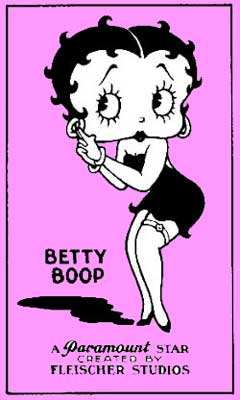Part III: Betty Boop in the Sing-Alongs,
Following the Bouncing Ball
The Fleischer brothers began issuing "Screen Songs" episodes in 1929 & continued through 1938. Some of these overlapped with Betty Boop cartoons, though often Betty was featured only in passing.
An earlier group of films were the thirty "Song Car-tunes" issued between 1924 & 1926, which were likewise follow-the-bouncing-ball singalongs, but predate the existence of Betty Boop. The earlier ones were "phonofilms" that required a phonograph record to be played along with the projection of the cartoon. Some of these were re-released beginning in 1929 with new soundtracks when rapid technical advancements made phonofilms obsolete.
The typical structure for the Screen Songs was to have a popular singer do their own song in live-action footage, followed by a second & third rendition showing the lyrics at the bottom of the screen with a "follow the bouncing ball." These were truly precursors to modern music videos.
Generally the bulk of the animated portion would preceed the live action, but there was often a live action teaser prefacing the cartoon.
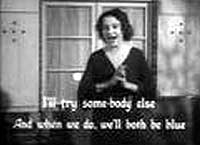 A young Ethel Merman is shown live-action singing the title song You Try Somebody Else (1932) immediately before the cartoon opens with a prison scene.
A young Ethel Merman is shown live-action singing the title song You Try Somebody Else (1932) immediately before the cartoon opens with a prison scene.
A glad-looking butch cat has just finished serving his time. "Now for a new start!" he tells himself. Being a cat burglar at heart, he goes in search of the nearest safe to crack. When he gets it open it's really a refrigerator & he prepares to eat a fish, which is soon begging him for mercy.
It's Betty Boop's house, & she's heard something in the kitchen, so comes tiptoeing through the house in her nightclothes with a shotgun, catching the thief all by her brave self.
Back in jail the kitty goes. He has nothing to do but read the newspaper. There's a story in the paper about Ethel Merman, whose photograph comes alive for a Follow the Bouncing Ball live-action sequence featuring the title song.
Ethel's belting voice is great, & when young & slim she was quite the statuesque beauty. The last time through the song we return to the animated prison setting for a few final gags, climaxing in a prison break.
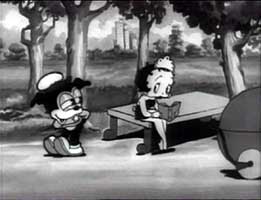 Ethel Merman also sings the title song of Let Me Call You Sweetheart (1932). The prelude shows Ethel in person. Cut to Betty babysitting Alyosius. A beat-cop played by Bimbo the Dog catches sight of the nanny & begins flirting outrageously.
Ethel Merman also sings the title song of Let Me Call You Sweetheart (1932). The prelude shows Ethel in person. Cut to Betty babysitting Alyosius. A beat-cop played by Bimbo the Dog catches sight of the nanny & begins flirting outrageously.
She ignores him for as long as she can, reading a book. Bimbo grabs Betty very aggressively & accidentally kicks Aloysious's stroller down a hill into a pond. The baby turns the stroller into a boat & rows ashore. He skips to a vendor's food cart in the park & tries to sneak some cake & swipes a hotdog.
Betty meanwhile lets Bimbo keep his head in her lap, & she seems to have no recollection of the baby. However, unexpectedly the baby's in bed at night & he asks Betty if he can hear the song "Let Me Call You Sweetheart."
The cartoon cuts just as awkwardly to live action of Ethel singing. After she sings it once, a "following the bouncing ball" lyric appears on the bottom of the screen for a second go. The third go, the lyrics on the bottom of the screen are in amusing typefaces with visual puns.
When the singalong is done we cut to a chicken with her eggs. Three eggs hatch, & a scary cat ironically sings the title song while trying to eat the hatchlings.
The structure of this film is pretty bad & the closing final animation is totally generic rather than returning to Betty for a close. Hardly worth it as a cartoon, but worth it for Ethel Merman fans.
"The Wandering Minstrels" Les Reis & Artie Dunn open this short film as live-action figures "for the first time on the screen," wearing their military uniforms, singing the title song, Irving Berlin's Oh! How I Hate to Get Up in the Morning (1932).
It then turns into animation of an army camp at dawn, with the sun itself blowing revelie. Some original & amusing gags include the trees awakening & scratching their behinds, a canon yawning as it wakes, a spark of flame in a fireplace waking up & preparing to be a fire (how there's a log cabin with a fireplace in the military camp of tents isn't immediately clear, but it'll turn out to be the mess hall), & a wind-up alarm clock getting annoyed because the dogs on their army cots won't wake.
Pretty good gags keep coming & the wardogs all head for the mess hall, where Betty in Red Cross or nurse's outfit starts the day off for them with a song. She draws a bouncing ball on the blackboard so it becomes a Follow the Bouncing Ball film, with the Wandering Minstrels reappearing as live-action footage above the lyrics.
Despite that Betty's only in the film for less than thirty seconds & half of it isn't animated, this is a pretty cool cartoon, certainly one of the best of the sing-alongs when assessed for comedy.
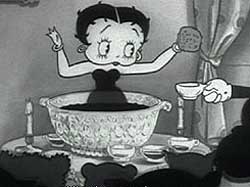 Rudy Vallee opens the cartoon Rudy Vallee Melodies (1932) in live-action footage singing a fragment of "Keep a Little Song Handy" but then it goes right into animation. There's a party at what looks like a men's club or frat house, but it's actually Betty Boop's personal mansion.
Rudy Vallee opens the cartoon Rudy Vallee Melodies (1932) in live-action footage singing a fragment of "Keep a Little Song Handy" but then it goes right into animation. There's a party at what looks like a men's club or frat house, but it's actually Betty Boop's personal mansion.
She's first seen standing in a bowl of punch serving the boys spiked punch, a few of the party-goers being already drunk. Betty asks "Who can sing or dance?" A rabbit says he can play the piano, & Samson, a tiny bug, brings in a piano.
The rabbit doesn't read music. "I only play by ear." Literally. Betty says she'll play the piano if someone else will sing. Everyone says they don't want to sing, not even Percival the faggot ferret who gets queer-bashed.
Rudy, whose living picture is on the front of the sheet music, says he'd be glad to sing a melody, if everyone else would sing along with the bouncing ball. There follows renditions of the crooner tunes "Deep Night," "A Little Kiss Each Morning," & the Maine glee club marching tune "Stein Song."
When the party's over, Betty reappears just long enough to say good night. She turns in & Rudy in the picture frame by her bed is singing "Good Night Sweetheart."
This nice episode overall. Rudy also appears with Betty in Kitty from Kansas City (1931) & in Betty Co-ed (1930) featuring a flapper who isn't Betty Boop per se.
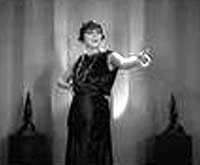 Irene Bordoni (1895-1953) appears in the live-action prelude, singing the title song Just a Gigolo (1932) in French. Though 1932 was the height of Betty's fortunes, this time the French flapper completely upstages Betty. Irene had popularized the Cole Porter song "Let's Do It, Let's Fall in Love" & Porter included a lyric referring to her in "You're the Top," ie., "You're the eyes of Irene Bordoni."
Irene Bordoni (1895-1953) appears in the live-action prelude, singing the title song Just a Gigolo (1932) in French. Though 1932 was the height of Betty's fortunes, this time the French flapper completely upstages Betty. Irene had popularized the Cole Porter song "Let's Do It, Let's Fall in Love" & Porter included a lyric referring to her in "You're the Top," ie., "You're the eyes of Irene Bordoni."
She starred in the Broadway play Paris & in its film adaptation that same year (1929). Irene was, like Helen Kane upon whom Betty was based, the quintisential flapper of the late 'teens & throughout the '20s.
As the cartoon opens, a hippo dressed working class is waylaid at the entrance of a jazz club & forced to wear better clothes before allowed inside. Betty Boop is the cigarette girl. She sells whole cigars ten cents each or two for a quarter. Cigar stubs are much cheaper as "Fire Sale" items.
The lights go down & Betty in tophat introduces Irene as a live-action figure singing the titular song in English. It's a nice performance despite that it's neither Betty nor even a cartoon during the performance. After going through the song the first time, it turns into a "follow the dancing ball" sing-along for a second go-through.
The beat is picked up for a third go sung only by the audience while Irene conducts. A fourth time through we return to the cartoon, which is about a tom cat on the make in the moonlit night. Betty doesn't even say goodbye, so her screen time in eight minutes is minimal.
Another of the "Screen Songs" series "with the famous bouncing ball," Popular Melodies (1933) features music by Arthur Jarrett (1907-1987). Jarrett was a popular singer of the '30s & '40s & sang with the Red Nichols Orchestra & others, & introduced "Let's Fall in Love" & "Did You Ever See a Dream Walking" about the same time he did his second Screen Songs episode with Betty.
A painter in his garret is trying to get some work done on a painting while his five children are rowdy. He finally gets enough I kicks one of the children across the floor. The kicked kid doodles on one of the paintings.
The painter decides to go work out on the countryside, but the kids refuse to be left behind & pile in the car to go along. Of the several driving gags, the most surreal is how the car sometimes falls into pieces, bounces along in bits, then puts itself together.
Finally our painter has his easel ready & a tree starts posing for him, when unexpectedly the canvas has Arthur Jarrett with his guitar as live action. He sings "My Silent Love" including the lyric "I reach for you like a star" with the bouncing ball keeping the beat along the top of the lyrics.
He next sings "One Hour With You" as he puts his guitar aside & takes up pen in order to draw Betty Boop on the paper on his easel, tying the theme of the live-action bit to the cartoon about the painter.
Having sun his love song to a pleased Betty, he lastly sings the theme song "Betty Boop" with Betty herself doing some of the booping.
We're then taken back to the painter & his children for a few closing gags, & to discover that instead of being angry at their noisiness, he's now teaching them to be painters. The scariest drawings become a dancing troupe running about the countryside & a hideous devil looks out from the screen to say, "Pleasant dreams children, mwoo-ha-ha-ha, good night."
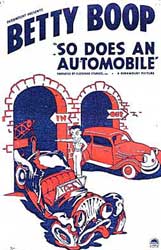 Betty dressed in gas station attendant bib overalls works at the automobile hospital or junk yard. She is approaching the end of her cartoon career. She appears right from the first moment of the cartoon singing the title song So Does an Automobile (1939) about how cars & people share a lot traits in common.
Betty dressed in gas station attendant bib overalls works at the automobile hospital or junk yard. She is approaching the end of her cartoon career. She appears right from the first moment of the cartoon singing the title song So Does an Automobile (1939) about how cars & people share a lot traits in common.
Betty's voice is the familiar one but the singer is Margie Hines (aka Margie Heinz) rather than Mae Questal. Margie was the first wife of Johnny Mercer. From 1939 to 1944 she took over from Mae Questal the voice of Olive Oyl, & Betty just for late 1939.
In the Production Code era (beginning in 1934) she had not been allowed to be her full sexy self & had been revamped as a kiddy cartoon character which was not suited to her buxum self, & so was losing rather than gaining popularity. She was frequently reduced the role of cook or babysitter instead of a dance hall girl. But in this one at least she's a blue collar worker rather than homebody housekeeper.
The garage is set up like a hospital. An ice truck has caught cold. Another vehicle is drunk, sufering from auto intoxication. A race car is worn out from "too much fast living." A jitter buggy suffers from nerves. A car suffering from insanity as cracked cylinder head.
Several more punning gags & medical treatments proceed in rapid succession, a lot of it genuinely funny stuff, with some very amusing sentient car characters. As a reminder of how old some slang is, a truck does a little jazz dance saying, "Yeh yeh yeh, truck on down, swing it, yeh baby" then cuts to Betty doing the same finger-wagging dance.
There's an emergency call for an ambulance tow truck. "Hurry!" says Betty. "I hope it's not a crank case!" It's a pregnant auto which gives birth to two little toy cars.
copyright © by Paghat the Ratgirl
|
